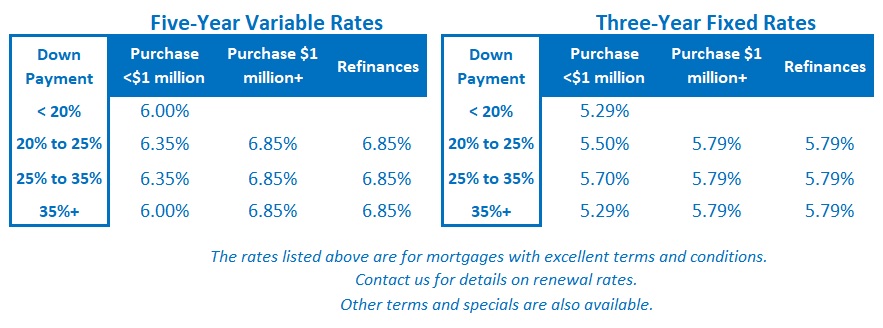Canadian Mortgage Rates Are Set to Drop Again (Thanks to the US Fed)
December 18, 2023The Bank of Canada’s Inflation Pickle
January 15, 2024
Happy New Year and welcome back!
In keeping with tradition, my first post in 2024 will offer some thoughts on the year ahead – but before I jump in, let’s take a quick look at how my 2023 prognostications turned out:
2023 Prediction #1 – Central bankers will no longer have the market’s back.
Excerpt: We have come to the end of a long period when bad news for the economy was good news for financial markets because it led to central-bank rate cuts, the continuation of ultra-low rates, and/or other forms of monetary-policy largesse. Going forward, good economic news will be bad news for the financial markets because it will reinforce the need for higher rates.
Verdict: That call held up.
2023 Prediction #2 – Inflation is going to be stickier than expected.
Excerpt: I expect that we will finish 2023 above the Bank’s current Q4 forecast of 2.8%. Our average year-over-year wage growth has clocked in at 5%+ for the past seven months. I can’t see our overall CPI dropping much below our average wage-growth rate for a sustainable period because labour costs are so pervasive. I also don’t see any signs that our wage growth will slow any time soon.
Verdict: Inflation was 3.1% at the end of 2003.
2023 Prediction #3 – The BoC won’t pivot in 2023.
Excerpt: The Bank may not yet have finished hiking rates. Our strong employment data increase the odds that we’ll see at least one mortgage-rate hike when the BoC next meets on January 25, and it is not out of the question that we could see another hike at its meeting on March 8. Inflation is much higher now than it has been during our last several tightening cycles. As per Prediction #2, it has broadened across our economy and is being underpinned by wage growth that hasn’t produced any real income gains for workers to date.
Verdict: The BoC paused in January but hiked two more times last summer. We’re still waiting for the pivot.
2023 Prediction #4 – Our housing markets won’t crash.
Excerpt: I think house prices in most markets could finish the year lower, but not dramatically so. I expect price declines of no more than 10%. While higher mortgage rates are certainly putting a strain on homeowners and will likely limit further price gains over the near term, our regional housing markets are well positioned to withstand a slowdown.
Verdict: It was another disappointing year for the doom-and-gloomers.
2023 Prediction #5 – The stress test won’t be reduced or eliminated in 2023.
Excerpt: I don’t see our banking regulator giving housing demand a massive boost at a time when we need less demand to help reduce inflation. At some point in the future, if inflation is back under control and our prevailing borrowing rates aren’t stimulating enough housing demand, it may play that card. But not in 2023.
Verdict: There was no change to the stress test in 2023.
2023 Bonus Prediction – Fixed Mortgage Rates
Excerpt: I expect our fixed mortgage rates to remain at their current levels [five-year fixed rates were around 5%] over the very near term. I also expect that they will rise above their current levels as financial markets pay more heed to the higher-for-longer warnings coming from both the Fed and the BoC.
Verdict: Higher-for-longer became the consensus forecast, and five-year fixed rates peaked at just under 6% last fall.
We begin 2024 in a period of transition. With that in mind, here are three mortgage and real-estate-related predictions for the year ahead.
- The BoC will substantially reduce its policy rate in 2024.
Today’s variable-rate mortgages are priced at rates that are 1% to 1.5% higher than three- and five-year fixed-rate options.
Anyone choosing a variable rate today must believe that their rate will fall below today’s available fixed rates, and with enough time left on their term to recoup the higher initial cost plus some additional saving.
That means rates would have to start falling substantially, and relatively soon.
I expect both things to happen.
Our economy has already slowed to stall speed, inflation is demonstrably cooling, and most of the remaining price pressure is coming from higher borrowing costs imposed by the BoC. (If higher rates are causing inflation, that inflation can’t be cured by raising rates further.)
In December, Statistics Canada reported that Canadians directed a record portion of their disposable income to debt repayments, and that’s with less than half of mortgage borrowers having renewed at higher rates thus far.
Also, as the proportion of mortgage borrowers impacted by higher rates increases, as more borrowers are forced to renew, so too will the gap between their old and their new rates.
Last year the typical renewer was coming out of a five-year fixed-rate mortgage in the 3.5% range and locking in a new fixed rate that was about 2% higher. But because rates were on a declining trajectory five years ago, in 2024 the typical renewer will be coming out of a rate lower than 3.5%.
That wider gap will increase the size of the payment shock, causing a further cooling effect on demand.
When demand weakens to the point where the BoC is satisfied that inflation is “clearly on a path to 2%”, it will begin cutting to move its policy rate back to a neutral position where it is neither constraining nor stimulating the economy.
The level of that neutral rate is debatable but is generally believed to be about 3%. I think that weaker-than-expected economic data in 2024 will compel the BoC to beat a hasty retreat to a neutral policy rate before the end of 2024.
- Our fixed mortgage rates will drop in 2024, but not nearly as much as our variable rates.
Variable mortgage rates won’t fall until the BoC cuts its policy rate, but our fixed mortgage rates have already moved lower in anticipation of that outcome because the Government of Canada (GoC) bond yields on which they are priced are forward looking.
In other words, our current fixed mortgage rates have already priced in substantial rates cuts by the US Federal Reserve and the BoC in 2024. That reduces the potential for further decreases.
- Canadian real-estate markets may prove more responsive than US real-estate markets.
I think we’re headed for a muddle-through year for most of our regional real-estate markets. Sellers with options will hold out for higher prices. With mortgage rates still well above their average levels, buyers will be willing and/or able to stretch only so far..
On first pass, one might assume that the typical US real-estate market is in for a better year than the typical Canadian real-estate market.
Canadian households have higher average debt levels, largely because US household debt declined during the 2008 financial crisis while Canadian household debt continued to expand. That difference makes Canadians more sensitive to higher borrowing rates, as does the fact that Canadian mortgage rates are typically locked in for only five years, whereas US mortgage rates are typically locked in for 25 to 30 years.
All this means that Canadians feel the impact of higher rates more severely and much more quickly. But shorter mortgage terms also mean that Canadian real-estate markets are likely to reset faster.
US borrowers who are currently sitting on 3% rates with 10+ years left on their terms are understandably reluctant to give up those rates and double their interest cost to buy a new property (because US mortgages aren’t portable).
If you’re looking past the economic slowdown to come, consider that while Canadian real-estate markets are currently more vulnerable to price corrections than US markets, our shorter mortgage terms (and portability features) increase the likelihood that they will also benefit more quickly from lower interest rates. That has important implications because real-estate sectors typically lead economic recoveries.
My Mortgage Selection Advice for Early 2024
If you’re in the market for a mortgage today, variable rates are worth considering if you can tolerate payment risk and are prepared to be patient. That view is underpinned by my belief that rates have already peaked for this interest-rate cycle.
On the other hand, if you’re concerned that inflation will prove stickier than the consensus now expects, which many smart observers still predict, I think a three-year term is the best currently available fixed-rate option. (The rate premiums for one- and two-year fixed rates remain prohibitively high, and I still worry that five-year fixed rate terms will lock borrowers into a higher rate for too long.) The Bottom Line: GoC bond yields (and their US equivalents) have moved higher of late, but this was not unexpected after yields swung sharply lower to end 2023.
The Bottom Line: GoC bond yields (and their US equivalents) have moved higher of late, but this was not unexpected after yields swung sharply lower to end 2023.
That rebound has returned gross lending spreads to their normal ranges, and as such, I expect fixed rates to hold steady over the near term (barring a surprise in the US CPI data this Thursday).
Variable-rate discounts have tightened lately, and variable mortgage rates are now 1% or more higher than fixed mortgage rates. That said, these rates aren’t likely to increase further, and I expect them to fall quickly once the BoC starts cutting.







